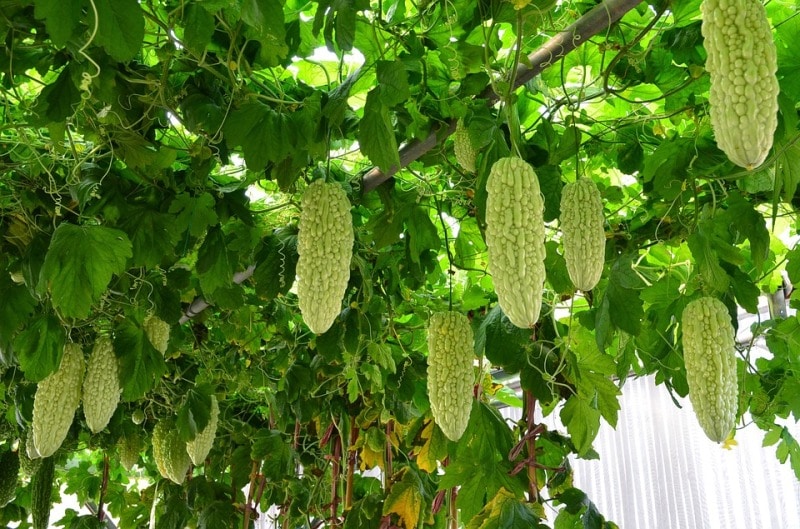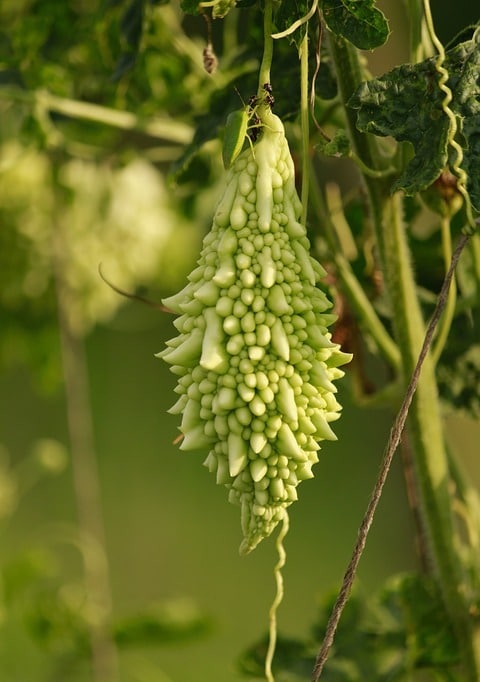A step by step guide for growing hydroponic bitter gourd
Today, we learn the topic of growing hydroponic bitter gourd, hydroponic bitter melon nutrient solution, and hydroponic bitter gourd fertilizers. Bitter gourd commonly recognized as karela isn’t all that bitter as it tastes. Although its bitter taste may turn some people away from it, in fact, it can really sweeten your health by virtue of its disease-preventing and health-promoting phytochemical compounds present in it. It is a wonderful vegetable rich in calcium and Vitamin C. Cultivated expansively in India and China, the bitter gourd is well known to reduce blood sugar levels in diabetics this is why it is often advised for diabetic patients. Bitter gourd belongs to the Cucurbitaceae family, the same family as the melons and gourds, etc. The scientific name for Bitter gourd is Mormodica charantia.
Since this crop so much beneficial so why not grow it at your own place and harvest fresh and organic for this hydroponics technique is the savage. Yes, friends’ bitter gourd hydroponics is possible and has been practiced by enthusiastic gardeners.
So today we will have a discussion on growing bitter gourd plant in a hydroponic system.
Let’s get started.
The growing season for bitter gourd:

Though bitter gourd is a warm-weather crop, but hello! We are talking about hydroponics where bitter gourd can be grown throughout the year provided it is not exposed to extreme cold conditions and proper nutrient requirements and pH range is being taken care of. The best season to enjoy growing bitter gourd is between April – May, and July – September.
You may be interested in Hydroponic Bottle Gourd Farming.
Mature bitter gourd plant bears deeply lobed leaves and grows in a fashion alike squash, cucumbers, and watermelon having vines 13 to 16 feet long if it is left unpruned. Fruits are light to dark green colored, oblong and either smooth or warty, typically about 8 inches (20 cm) long but fruits can differ in length between 2 and 10 inches (5-25 cm) long. The fruit changes in color from green to yellow to orange as it ripens and over-ripens.
Location constraints for bitter gourd gardening:
It is well known that hydroponics enables us to grow our favorite plant be it herb, fruit or vegetable in indoor conditions same is for bitter gourd too. But here because of the plant growth habit, the plant needs to be exposed outdoors but don’t worry you don’t need to dig soil you just have to arrange trellis or support example wooden trellis stand or plastic rope or wire to make a temporary arrangement for the creeper so that the bitter gourd plant can spread properly as it is a typically vining plant. The bitter gourd plant is a creeper and requires a trellis set up to support the creeper. Choose a sunny spot for the system that receives a good amount of sunlight during the day. The crop must receive a minimum of six hours of bright sunlight every day you should choose the location of your system accordingly. Experienced growers believe fruit grown from a trellis grows longer and straighter than those grown on the ground as they will get proper space for the growth.
Propagating bitter gourd plant in hydroponics

For raising hydroponic plants you can start from seed or an easier way is to fetch transplants from a nearby nursery. But raising plants right from seed is more fun. Seeds can be purchased online or in any gardening shop. You can also use seeds you get from ripened yellow fruits. Ripened seeds have a crimson red-colored seed coat. Germination is not difficult in bitter gourd, but there are some hacks to speed it up.
Seeds germinate slowly in 3 to 4 weeks if you directly sow them without any pre-treatment, especially at low temperatures. But to enhance germination rate and for the faster germination, you can scarify the seeds to remove the hard seed coat. For this, simply rub the seeds from one side without doing any damage to endosperm present inside the seed coat, scarification enables the seed to sprout quickly. Soaking seeds for 24 hours prior planting in water will also help.
Sow seeds 2 cm deep. Seeds can be sown directly into the ground or in the growing media like coco-coir or Rockwool but only after the risk of frost has passed. Seeds require the temperature above 70 Fahrenheit (20 C) for germination and about 6 hours of direct sunlight. You can transfer the seedling after you observe 3 to 4 true leaves stage.
You may also like Growing Lemons In Pots.
Hydroponic system for bitter gourd farming:
Bitter gourd is a versatile crop you can supplement any of the hydroponic systems for its growth as long as you have a proper support system for its creeping vine. A hydroponic system such as Kratky, deep water culture (DWC) and nutrient film technique (NFT) is best recommended by the experienced hydroponic growers.
The best fertilizer for bitter gourd:
The nutrient solution is the soul of any hydroponic system since it is a soil-less culture so the plants depend completely on nutrient-enriched water stored in the reservoir of the hydroponic setup. Specialized hydroponic nutrient formulations are available in various horticultural stores both online and in markets with different brandings so you can easily get them and the best part is they are ready to use. You need to add the Calcium and Magnesium sulfate individually like most good vegetable formulas but it is worth the extra few minutes that it takes. Adjust your Ph to 6.4 to 6.7 and EC 1190-1750 PPM. Overdose of nitrogen-rich nutrients must be avoided, which will encourage the development of foliage at the expense of fruits which is undesirable.
How to prune bottle gourd in hydroponics:

The developing plant produces numerous side shoots or vegetative growth, which must be removed to improve yield. Side shoots should be removed (lateral branches) until the runner reaches the top of the trellis. Leave only 4–6 laterals and cut the tip of the main runner which will encourage flowering which will turn into fruits to improve the productivity of the plant. The growing tips of trellised vines are to be pruned or pinched as they reach the top of the support, as should long lower lateral branches. This will focus the plant’s energy and result in more flowers and fruit.
Pollination of bitter gourd plants for hydroponics:
Vines usually begin flowering about 5 to 6 weeks after planting. Male flowers open first making it a protandrous plant, followed in a week or so by female flowers. Both flowers are yellow in color. Female flowers have a slight swelling (the ovary) at the base of the bloom resembling a tiny fruit. In natural state Bees and pollinating insects visit both blooms, transferring pollen from male to female flowers which might not be possible always. Usually male flower (pollens) lives only for one day; they open in the morning and fall from the plant in the evening which has less chance of pollination.
Hand pollination: If there are flowers but no fruit forms which a common problem under the hydroponic system and you find no bees at work nearby your system, then you may suspect that pollination has not taken place. Pollination can be done by hand this is happening for cucumbers and squash as well. For pollinating you can pick male flowers and transfer pollen by touching the center part of the male flowers against the center of the female flowers where the stigma resides this will brush pollen on the female flower resulting in pollination and then fertilization.
After successfully pollination the ovary of pollinated female flowers will begin to enlarge and fruit will mature in about two to four months. Mature fruits will be ready to pick about 12 weeks of bitter gourd plant life span after planting.
You may also check Soilless Tomato Gardening.
Harvesting of bitter gourd in hydroponics:
You can harvest bitter gourd about 12 to 16 weeks after planting and 8 to 10 days after flower drop when the fruits are 4 to 6 inches (10-15 cm) long green in color. If fruits stay too long on the vine they will be over-ripened and they will turn all yellow, become bitter undesirable. Fruits on the same vine can vary in their degrees of bitterness gourds both immature and overripe can taste very bitter. Bitterness is due to the alkaloid momordicine found in growing bitter melons; the simple formula is darker the color of a bitter melon the more bitter and intense the flavor will be.
Mature and over-ripened yellow gourds can be used for seed production. To save seed for next season, leave a few fruits on each vine to mature post-harvest. Mature fruits will split open and liberate brown or white seeds. Collect the seed, sort it, wash it, and dry it then store them in a cool, dry spot. It will remain viable for about 2 to 3 years.
That’s all folks about growing hydroponic bitter gourd and happy hydroponics!.
You may be interested in Growing Organic Food Cultivation.
nice information, but just to clarify, 1190 – 1750 ppm is TDS that is required for bittergourds, or its the EC?